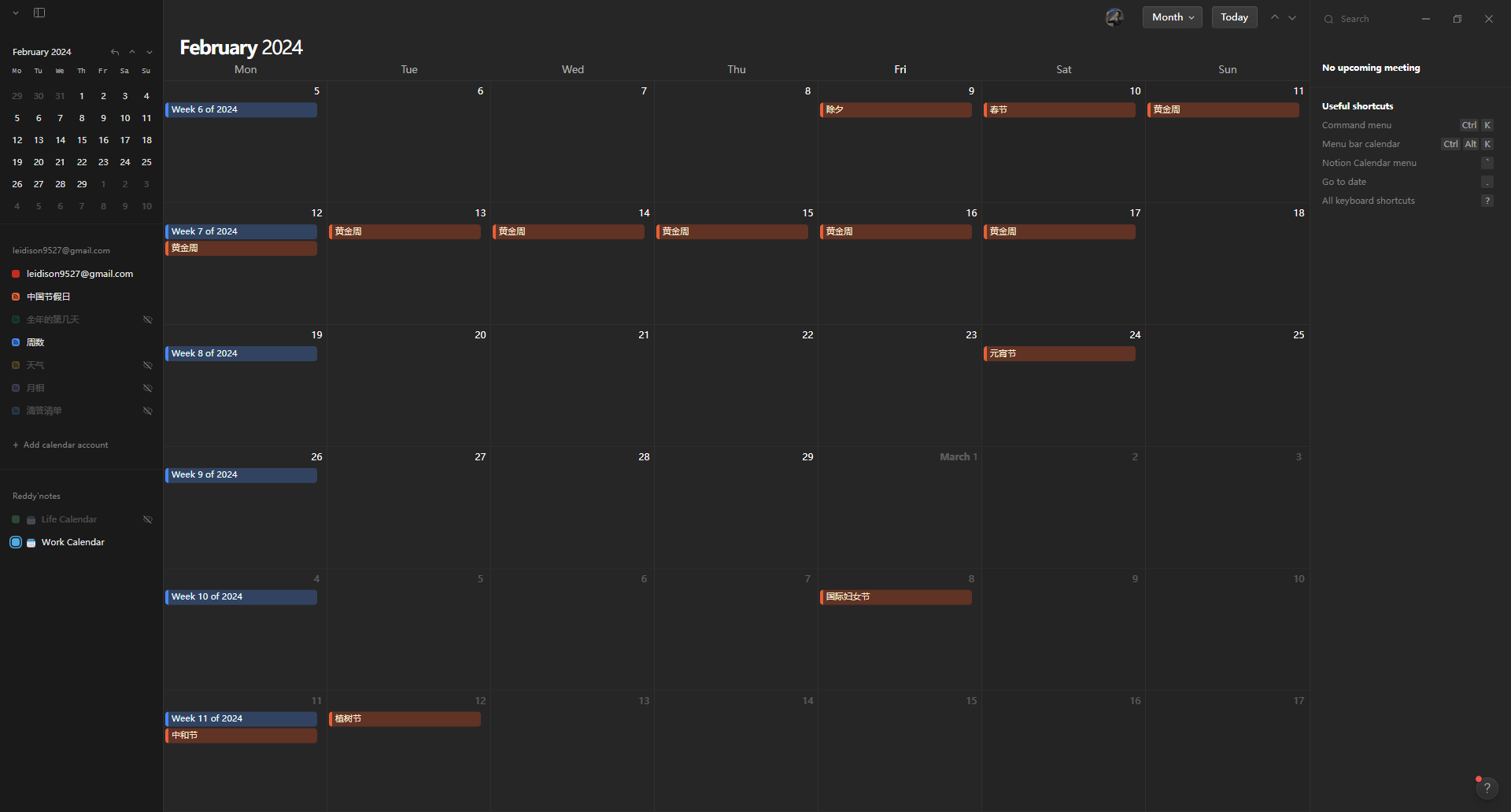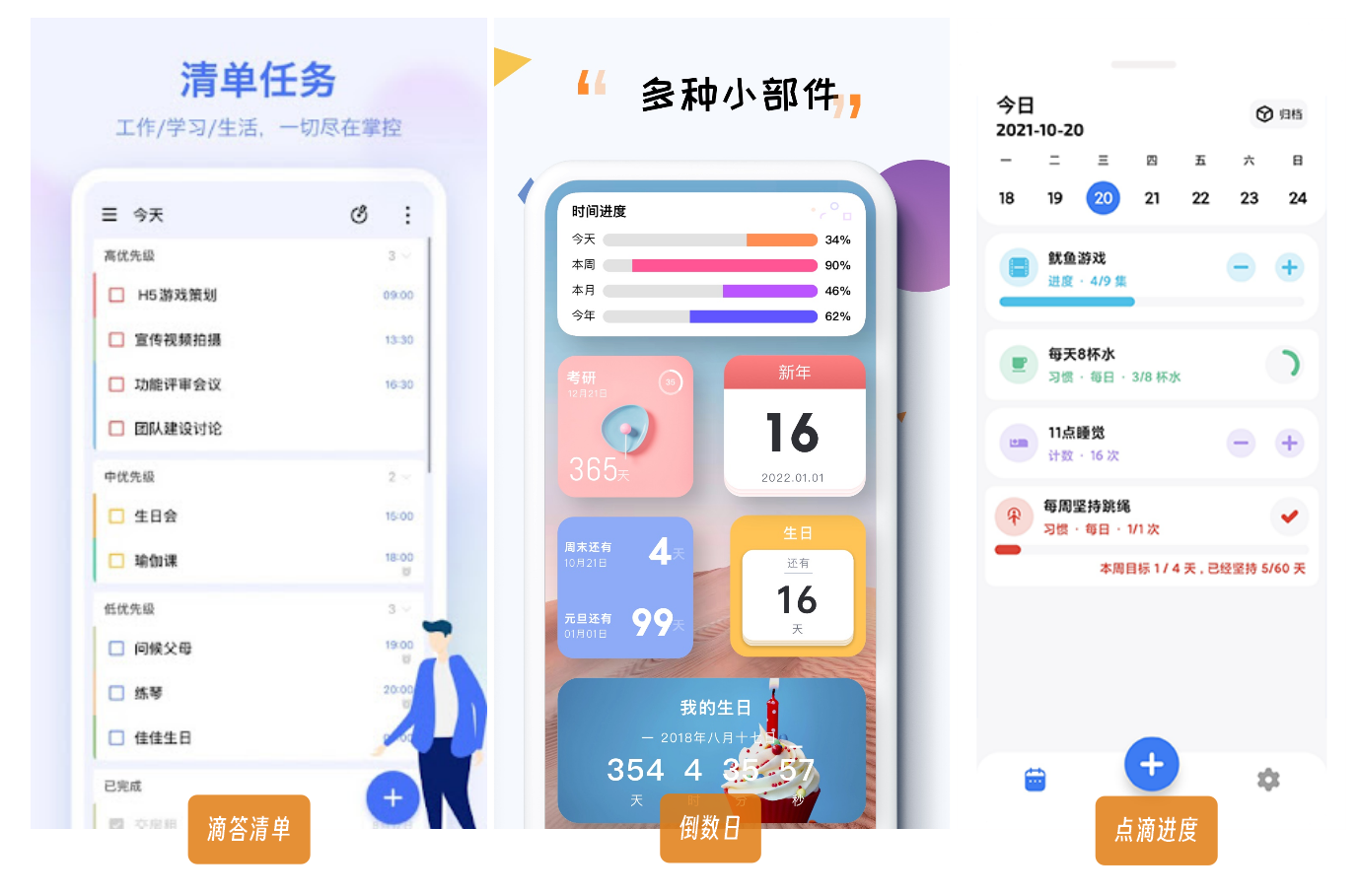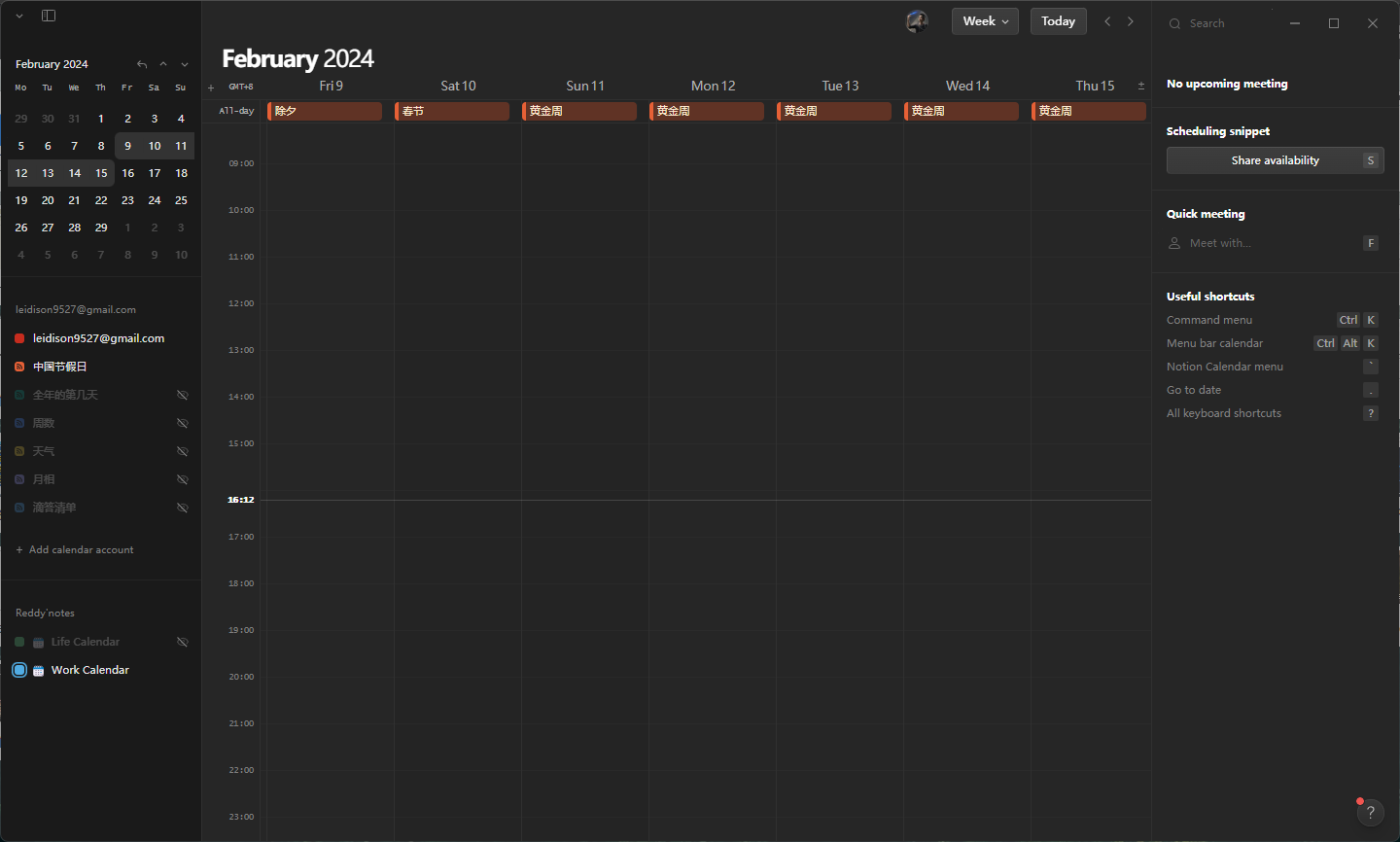时间是一种宝贵资源,无法再生。在工作任务、生活琐事、学习兴趣或新技能,每件事都需要耗费时间。精确掌控,做到游刃有余?实际上,这是一项艰巨任务。

分离生活和工作事务
我们要将生活和工作区分开。使用 Calendar 管理目标时,就应该明确它的使用范畴。比如记录 TODO,还是 OKR,或者记录约会,生日,纪念日等备忘提醒。
根据个人喜好及想要达成的目标,明确日历使用方法。
一旦确定,别的不相关的杂七杂八就不要往里放。
我把生活琐碎交给「滴答清单」,它包含:购物,生活,各种电费,水费,分期等循环提醒。做完一个任务,点掉它,大脑清爽。
虽然滴答清单可以分类,通过不同文件夹,将生活和工作分开,可从内心感受出发,滴答清单更像垃圾清理工具。
倘若把工作任务放在滴答清单。一方面觉得不够重视;另一方面觉得生活同工作应该分开看待。
我下班不想看到待办清单中还有工作相关任务没有完成,看着多闹心!
那些并不重要的碎片化任务唯一作用就是提醒我别忘记做,但就算忘记也无关紧要。避免大脑存储过多多余信息,比如「晚上去超市买牛奶」,「给汽车换机油」…尽管数据非常小,但它实打实占用大脑内存。
关键在于工作任务通常是一个完整的时间段,并非几点几分就能说完就完。它相对复杂,随着某些变量而改变,工作需要协同,一个人无法掌握精确进度。
总而言之,任务倘若无法在待办中及时清理,就会造成心理负担。
不同任务需要不同管理工具
不同任务,不同项目,不同习惯…需要有不同侧重 APP 分别管理。
把结婚纪念日,亲人生日统统交给「倒数日」,该 APP 有非常精美的桌面小组件,距离谁的生日还有几天,提醒我买礼物🙃。
此外还有一款「点滴进度」,可以记录特定项目的时间进度。比如:「杨梅酒」浸泡时间「已经 6 个月 29 天」;「距离上次痛风」发作「已经 4 个月 9 天」。能够直观监测到某种食物正在悄然发生变化,独特风味,静静发酵,那是时间的味道。
我们不难看出,各种任务被分门别类管理。但对工作项目管理,仍存在阻塞。内心有些抗拒,上班就是摸鱼,你他妈别给老子找事情!
有时候我们只想把事情做顺,这样可以腾出更多时间摸鱼🐟。
如果一整天都被工作琐事缠绕,分身无力,被工作牵着鼻子走,这不是我们想要的结果。

使用 Calendar 明确工作时间
在日历上,确定工作时间,从心理上对生活与工作切割,明确生活和工作界限。
日历使用周显示,一周显示五天,每天划分「8:00-11:00」与「13:00-17:00」 有效工作时间块。所有工作任务通过划拉当日时间轴创建计划或执行后记录。
除非自己没有把握,需要他人协同,任务一旦确定划给某个时间块,就应该被严肃对待,尽可能按时间轴完成任务,或者某个时间段做某件与工作相关的事情。
起初我对工作日程,喜欢添加标签,比如:拍照,拍视频,海报等,这样的好处是可以在 Notion 中,使用表格显示。比如这一年,这一个月,我拍了几张照片,剪辑几个视频,设计几张海报。这种量化的数据年底做报告时,非常晃眼。
今年我不算分得这么细,按每日时间顺序,记录发生在工作时间的有效专注。工作时间以外与工作不搭界的事情,全都交给滴答清单。
于是就有了两个日历,生活与工作。
时间管理基于 「一定会发生的事情」,没有固定时间的日程没有意义。
时间一到,屁股不动,没有按照日程表执行,这个日程顶多算备忘。你大概能从每月满满当当的格子里催眠出一种我做了很多事情的幻觉。
鸡毛蒜皮的事情也算日程?刷鞋子,给老婆带饭…这种和目标管理相去甚远。用这种方式使用 Calendar,可以当作日记的延伸或补充。
可我们需要 Calendar 不应该只是当作日记存在,日记有日记写法。
日历,每天一小格,它的形状设计,限定范围。
别把无关紧要的任务填充在格子里充当门面,自欺欺人。
日程核心,时间轴。你从前往后,从上往下,按照时间顺序做事情。
这一天你做了哪些事情,展露无余。
没有开始→结束时间的任务不要放在日程,没有固定时间的任务很难被执行,容易露怯。
TODO 和 Calendar 区别
TODO 和 Calendar 区别,前者任务是不固定的,以最终完成为结果,什么意思?今天要洗车,上午记得充话费,淘宝买一个 U 盘…这些任务没有固定时间,完成划掉,无需回溯。
Calendar 根据时间顺序,线性记录。不要把 TODO 思维带进日历管理。
Calendar 用法是划拉时间块,按照时间顺序:「8:00~9:30 准备开会使用 PPT」,「10:00-11:00 关于大师海报的设计」…柳比歇夫时间统计术了解下。
不管提前规划的日程还是执行任务以后补录的日程,都行,但只要记录这一天有效的工作事件。
注意,这里的关键点在于「有效」。撒几泡尿,中午吃什么,喝几杯水,重复无意义的事情不要往里填。
随时随地,脑子拎清,日历格子很小,工作日历就写与工作相关事情。
我们记录这一天的工作究竟有什么用,这跟 TODO 记录一条条工作任务然后划掉有什么区别?有区别。TODO 不回溯,划掉等于删除,告诉大脑,这件事情结束,Game over,释放大脑内存。
没人会去找三年前某一天你冲了多少话费。当然也有一定类似超市小票的功能,比如别人问我上次买的鞋子多少钱。我快速搜索,找到那一条 List。但这种搜索找记录的频率少之又少。
我个人从来没有用过滴答清单搜索,它最大作用,记下鸡毛蒜皮的事情,做完就丢,保持大脑清爽。你又不是鲁迅,谁在乎你今天吃什么看什么。
Calendar 需要回溯,从一周五天,开始回顾。这一周工作,我哪个时间段,做哪些事情,用多长时间。一天看不出,一周,一月,你就能够慢慢感觉到一些不一样的东西,那种东西叫「规律」。
以设计为例,任何一个项目都是小部件组合而成。拍摄,修图,剪辑,文案,每个任务需要多久,通过日积月累,得到越来越精准的反馈,从而构建完成大项目的信心,并且能够给出具体时间限定,显得又专业又能干。

回溯日程,找到自己的办事节奏
Calendar 通过日积月累的日程,不断回顾,反复推敲,找到自己做事情又快又好的规律。俗称,办事节奏。
这里面很容易踩坑的地方就是完全照搬柳比歇夫时间管理。吃喝拉撒,事无巨细,统统记录下来。时间轴,密不透风,看着这样的日程表,简直透不过气。
谁会这样上班?80%时间摸鱼,好伐啦。
Notion Calendar 更新之后,让我有了 ALL IN ONE 想法。原本我通过「腾讯轻联」将滴答清单完成的任务同步到 Notion 日历,我为什么要做这一步?
通过滴答清单分类任务,比如:设计,写作,生活…Notion 用一套数据,筛选不同类别,于是得到:设计日历,写作日历,生活日历。
其实没啥用,仅仅看着清爽,感觉自己做事情,很有逻辑,很有层次。
Notion Calendar 补足原本 Notion 日历短板,同时可以好几个日历像刷油漆一层一层堆叠,你想看哪个就点开哪个日历的小眼睛。
- 生活日历:滴答清单同步 Notion 生活琐碎 List 为一个日历,通常不点开,权当备份。
- 工作日历:Notion 新建一个 Work Calendar,显示模式为五天时间轴,按照当日有效专注,记录事件。
记录事件时,可使用类似 #写作 标签作为开头,后续在 Notion 中使用筛选功能,单独拎出一个页面,便于统计。Notion Ai 可以提炼标题固定格式的文字,也非常好用。
每次写日程,要额外添加一个「@设计 完成一张大师系列海报」,显得有些麻烦,如果确定后续不再 Notion 分页面统计,就无需使用这种写法。
因为 Notion Calendar 记录事件时的选项暂时还很少,没有对应属性可以选择标签,只好手动在标题创建可识别的字符,用于筛选。
有些人因为 Notion 系列产品没有中文而耿耿于怀,又因需使用架梯子嫌麻烦。可好工具能让你的工作事半功倍,不仅提升效率,同时拓宽思维方式。
方法总比困难多,不要被一些有的没的问题,阻塞你使用世界主流的效率工具。
Notion Calendar 是一款独立产品,它是 Notion 触角,尚在萌芽阶段,未来可期。
我们可以使用它,找到属于自己的办事节奏。
做事体,清爽一点,最好的。
发表回复